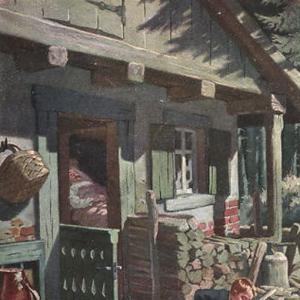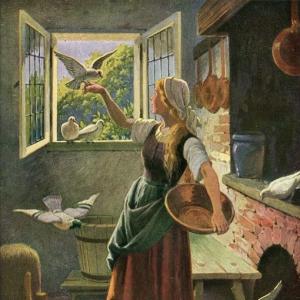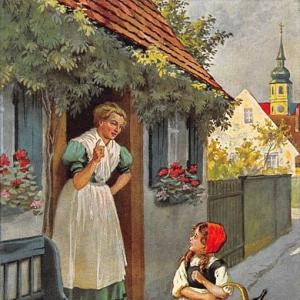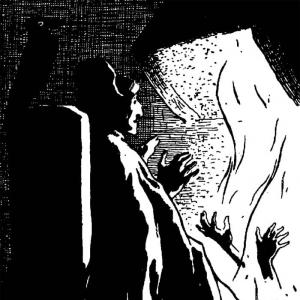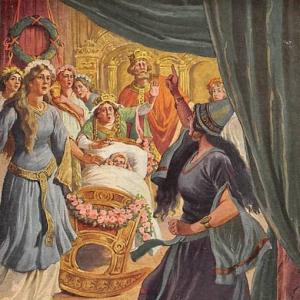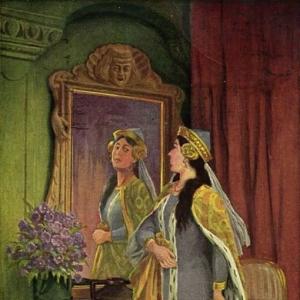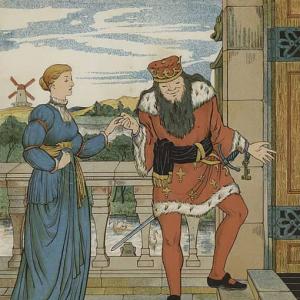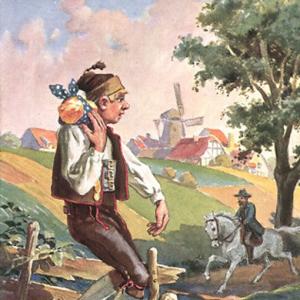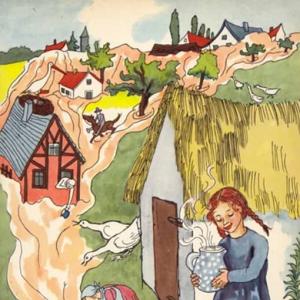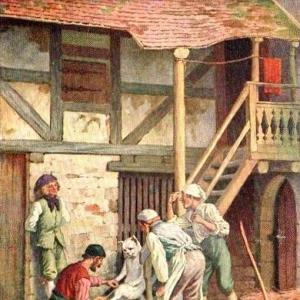Reading time: 3 min
I will tell you something. I saw two roasted fowls flying. They flew quickly and had their breasts turned to heaven and their backs to hell, and an anvil and a mill-stone swam across the Rhine prettily, slowly, and gently, and a frog sat on the ice at Whitsuntide and ate a ploughshare. Three fellows who wanted to catch a hare, went on crutches and stilts. One of them was deaf, the second blind, the third dumb, and the fourth could not stir a step. Do you want to know how it was done? First, the blind man saw the hare running across the field, the dumb one called to the lame one, and the lame one seized it by the neck.
There were certain men who wished to sail on dry land, and they set their sails in the wind, and sailed away over great fields. Then they sailed over a high mountain, and there they were miserably drowned. A crab was chasing a hare which was running away at full speed, and high up on the roof lay a cow which had climbed up there. In that country the flies are as big as the goats are here. Open the window, that the lies may fly out.
 Learn languages. Double-tap on a word.Learn languages in context with Childstories.org and Deepl.com.
Learn languages. Double-tap on a word.Learn languages in context with Childstories.org and Deepl.com.Backgrounds
Interpretations
Adaptions
Summary
Linguistics
„The Ditmarsch Tale of Wonders“ is a lesser-known fairy tale collected by the Brothers Grimm, Jacob (1785-1863) and Wilhelm (1786-1859) Grimm. The brothers were German scholars, linguists, and authors who are best known for their collection of fairy tales called „Kinder- und Hausmärchen“ (Children’s and Household Tales), first published in 1812. The collection includes some of the most famous fairy tales, such as „Cinderella,“ „Snow White,“ „Rapunzel,“ and „Hansel and Gretel.“
The Brothers Grimm collected their stories from various sources, including oral traditions, written manuscripts, and other storytellers. The tales often contained elements of folklore, mythology, and cultural heritage, reflecting the beliefs, customs, and values of the people from whom they were collected. As linguists and scholars, the Grimms were also interested in preserving the German language and its rich oral and written traditions.
„The Ditmarsch Tale of Wonders“ is unique among Grimm’s fairy tales, as it does not follow a traditional narrative structure or feature a clear moral lesson. Instead, it is a compilation of absurd and fantastical events that challenges the reader’s perception of reality and invites them to embrace the world of imagination. The tale is more of a humorous anecdote, showcasing the whimsical and playful side of the Brothers Grimm’s storytelling.
Ditmarsch (or Dithmarschen) is a region in the northern part of Germany, which was an independent peasant republic until 1559. The title of the tale suggests a connection to this region, possibly reflecting the local storytelling traditions or the unique sense of humor and folklore found in that area.
„The Ditmarsch Tale of Wonders“ by Brothers Grimm can be interpreted in various ways. Here are a few possible interpretations:
The power of imagination: The fairy tale celebrates the limitless potential of human imagination, presenting a series of fantastical events that challenge the boundaries of reality. It encourages readers to embrace the wonder and creativity in their own lives.
The absurdity of life: The tale highlights the unpredictability and often nonsensical nature of life by presenting impossible situations. It serves as a reminder that not everything needs to have a logical explanation and that sometimes, accepting the absurdity of life can be a source of amusement.
The importance of storytelling: As the Brothers Grimm were renowned collectors and authors of fairy tales, this story could be seen as a tribute to the art of storytelling. The tale’s structure and content emphasize the power of stories to captivate, entertain, and transport the audience to a world of wonder and fantasy.
A critique of human folly: The impossible scenarios and illogical events in the story can also be interpreted as a satirical commentary on human foolishness. The characters in the tale engage in absurd actions, like attempting to sail on dry land, which ultimately leads to their demise. This could be seen as a warning against blind ambition and the dangers of not questioning the rationality of one’s actions.
A playful challenge to the reader: The story can be seen as a playful challenge to the reader, encouraging them to suspend their disbelief and immerse themselves in the fairy tale world. By concluding the tale with the request to open the window and let the „lies“ fly out, the Brothers Grimm acknowledge the fantastical nature of the story and invite the reader to engage with the tale’s whimsical spirit.
„The Ditmarsch Tale of Wonders“ has not been adapted as frequently as some of the more well-known fairy tales from the Brothers Grimm collection. However, there have been a few adaptations in various forms of media:
Operetta: In 1901, the German composer Victor Hollaender wrote an operetta titled „The Ditmarsch Tale of Wonders,“ which was performed in Berlin. The operetta features music and lyrics that retell the story of Hans and the princess, along with a chorus and dancing.
Television: In 1957, the tale was adapted as an episode of the German television series „Die Märchen der Gebrüder Grimm“ („The Fairy Tales of the Brothers Grimm“). The episode, titled „Das Wunderpferd“ („The Miracle Horse“), follows the basic plot of the original story but with some changes to the characters and events.
Children’s book: In 1989, the American children’s author Jane Yolen published a picture book titled „The Miracle Horse: A Tale from the Brothers Grimm.“ The book features illustrations by Italian artist Gennady Spirin and tells the story of Hans and the princess in a simplified and child-friendly way.
Stage production: In 2019, a stage adaptation of „The Ditmarsch Tale of Wonders“ was performed in Germany as part of the annual „Fairy Tale Festival“ in Hanau. The production featured a mixture of live actors and puppets and incorporated elements of traditional German folk music and dance.
Overall, while „The Ditmarsch Tale of Wonders“ has not been adapted as frequently as some other fairy tales, it continues to inspire new interpretations and adaptations in various forms of media.
„The Ditmarsch Tale of Wonders“ by Brothers Grimm is a fairy tale that presents a series of absurd and impossible scenarios, showcasing the whimsical nature of the genre.
The tale begins with the narrator describing two roasted fowls that fly with their breasts facing heaven and their backs to hell. They witness an anvil and a millstone swimming gently across the Rhine River, while a frog sits on ice at Whitsuntide, eating a ploughshare. The story continues with three disabled men, one deaf, one blind, and one mute, attempting to catch a hare on crutches and stilts. Despite their impairments, they manage to do so through a chain of events: the blind man sees the hare, the mute man calls out to the lame man, and the lame man captures the hare.
Another bizarre situation occurs when a group of men decides to sail on dry land. They set their sails and glide across fields and over a mountain, only to be tragically drowned on land. Further strange events include a crab chasing a hare, a cow climbing onto a roof, and flies as large as goats. The tale concludes by urging the reader to open the window and let these „lies“ fly out, acknowledging the fantastical nature of the story.
The Grimm Brothers‘ „The Ditmarsch Tale of Wonders,“ is a concise but vivid narrative that reveals layers of meaning beneath its seemingly absurd surface through the application of linguistic analysis.
Absurdity and Surrealism
The tale is replete with absurd and surreal imagery, creating a sense of wonder and disbelief. These elements are linguistically significant, as they challenge the reader’s standard expectations of narrative coherence and reality. The use of contradictory elements, such as „roasted fowls flying“ with „breasts turned to heaven and their backs to hell,“ defies conventional logic and invites readers into a world where impossible events occur as a matter of course.
Syntax: The sentences in the tale are straightforward and declarative, which contrasts sharply with their fantastical content. This juxtaposition emphasizes the absurdity of the situations described. The directness of the language might serve to further highlight the surreal nature of the events by presenting them as mundane facts.
Imagery and Symbolism: The imagery is vivid and often incongruent, such as „an anvil and a mill-stone swam across the Rhine,“ which linguistically blends animate and inanimate characteristics. This can symbolize impossible feats or challenge perceptions of reality.
Irony and Paradox: The tale abounds with examples of irony and paradox, such as a blind man seeing, a dumb man calling, or a lame man catching a hare. These linguistic paradoxes play with the concept of ability and perception, undermining conventional power dynamics and roles.
Themes
The Subversion of Reality: By capturing seemingly nonsensical events with the same narrative tone as one might report the mundane, the tale disrupts the reader’s expectations of cause and effect, challenging perceptions of reality and prompting deeper contemplation of what constitutes truth.
Folkloric Tradition and Satire: The tale, situated within the oral tradition, may offer social or cultural commentary through hyperbolic and surreal descriptions, serving as a satirical reflection on human endeavors and ambitions.
The Nature of Storytelling: This narrative examines the nature of storytelling and the suspension of disbelief. By using impossible narratives structured within competent linguistic constructs, it highlights the boundary between reality and fiction and explores storytelling as an art of weaving fantasies.
Conclusion
„The Ditmarsch Tale of Wonders,“ through its linguistic composition, serves as an example of how language can be used to craft surreal and fantastical worlds. Its use of vivid imagery, irony, and absurdity invites readers to engage with the text on multiple levels, challenging their perceptions of reality while offering a playful critique of human ambition and storytelling itself.
Information for scientific analysis
Fairy tale statistics | Value |
|---|---|
| Number | KHM 159 |
| Aarne-Thompson-Uther-Index | ATU Typ 1930 |
| Translations | DE, EN, DA, ES, PT, IT, JA, NL, PL, RU, TR, VI, ZH |
| Readability Index by Björnsson | 26.1 |
| Flesch-Reading-Ease Index | 90 |
| Flesch–Kincaid Grade-Level | 5.1 |
| Gunning Fog Index | 7.6 |
| Coleman–Liau Index | 7.3 |
| SMOG Index | 6.6 |
| Automated Readability Index | 5.8 |
| Character Count | 1.068 |
| Letter Count | 824 |
| Sentence Count | 12 |
| Word Count | 210 |
| Average Words per Sentence | 17,50 |
| Words with more than 6 letters | 18 |
| Percentage of long words | 8.6% |
| Number of Syllables | 246 |
| Average Syllables per Word | 1,17 |
| Words with three Syllables | 4 |
| Percentage Words with three Syllables | 1.9% |
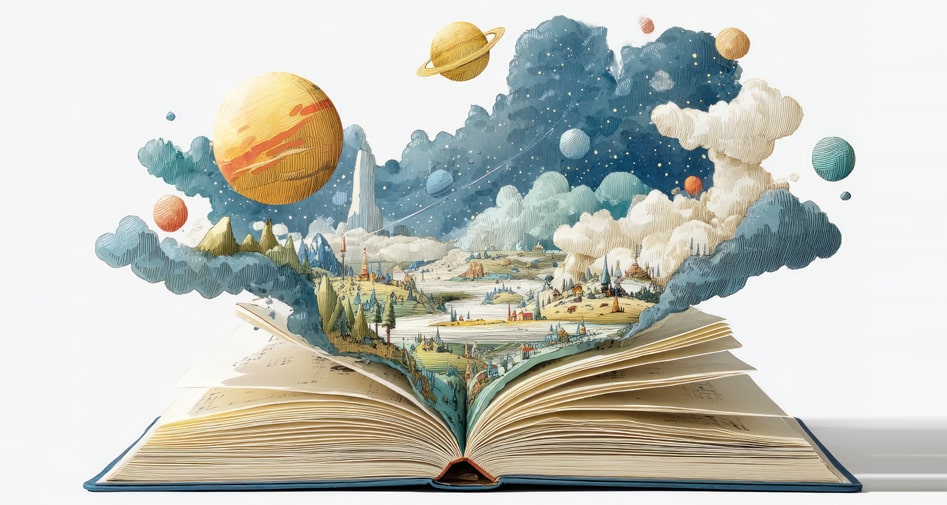
 Facebook
Facebook  Whatsapp
Whatsapp  Messenger
Messenger  Telegram
Telegram Reddit
Reddit





